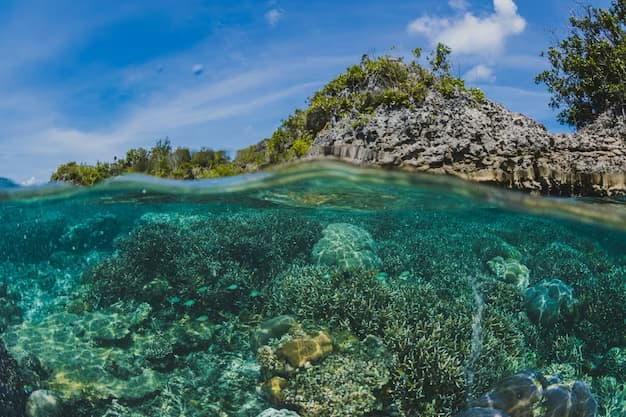The ocean encompasses various zones, each hosting unique ecosystems. Among these, the neritic zone stands out due to its remarkable light penetration, fostering an exceptional biodiversity level. This zone, stretching from coastlines to the continental shelf’s edge, is a vibrant marine environment crucial for supporting a wide array of life forms.
Characteristics of the Neritic Zone
Defined as the marine area from the shoreline to the continental shelf’s brink, the neritic zone features diverse depths, generally up to 200 meters. Its proximity to land and shallow nature allows for significant sunlight penetration, supporting photosynthetic life forms and a multitude of marine species.
Zonation and Depth Variations
The neritic zone’s structure is nuanced, with varying light levels and temperatures influencing its ecological composition. From the dynamic intertidal zone, through the stable subtidal zone, to the productive continental shelf, each subzone plays a role in the overall health and diversity of marine life in this area.
Biodiversity Within the Neritic Zone
Home to over a quarter of oceanic life, the neritic zone’s coral reefs and diverse habitats support an extensive range of species. This area’s unique conditions allow for the flourishing of countless fish species, invertebrates, and marine mammals, contributing to the ocean’s ecological complexity.
The Flora of the Neritic Zone
The zone’s flora, primarily phytoplankton, seaweeds, and various algae, form the basis of the marine food web. These organisms not only provide essential nutrients to a vast array of marine creatures but also play a critical role in carbon sequestration, highlighting the neritic zone’s environmental significance.
Fauna Diversity in the Neritic Zone
The fauna in the neritic zone is rich and varied, from the smallest zooplankton to large predatory sharks and dolphins. Coral reefs within this zone are biodiversity hotspots, supporting thousands of fish species and serving as vital nurseries for marine life.
Human Impact and Conservation Efforts
Human activities, including overfishing, pollution, habitat destruction, and climate change, pose significant threats to the neritic zone. These challenges require concerted global efforts to mitigate and ensure the sustainability of these critical marine habitats.
Strategies for Preservation
To safeguard the neritic zone’s ecological integrity, several strategies have been implemented, such as establishing Marine Protected Areas (MPAs), promoting sustainable fishing practices, reducing pollution, and addressing climate change through global cooperation.
Comparative Table: Zonation within the Neritic Zone
| Subzone | Characteristics | Depth Range | Ecological Significance |
|---|---|---|---|
| Intertidal Zone | Fluctuating exposure to air and water | 0 – 2 meters | High biodiversity, adaptation to extreme conditions |
| Subtidal Zone | Consistently submerged | 2 – 40 meters | Stable habitats, supports kelp forests and seagrasses |
| Continental Shelf | Broad, gently sloping underwater plateau | 40 – 200 meters | Rich fishing grounds, diverse marine life |
| Continental Slope | Steep decline beyond the shelf | Beyond 200 meters | Transition to deep sea, unique species |
The Interplay of Light and Life in the Neritic Zone: An Analysis
The neritic zone’s ecological dynamics are profoundly influenced by its access to sunlight. This light penetration fosters photosynthesis, crucial for the primary production that supports the zone’s complex food webs. The availability of light diminishes with depth, shaping the distribution and types of life found at various depths. The zone’s upper layers teem with life, from phytoplankton to large marine mammals, all reliant on the primary productivity driven by sunlight.
Moreover, the neritic zone’s proximity to landmasses means it is heavily impacted by human activities. Overfishing threatens its delicate balance, while pollution and habitat destruction from coastal development pose severe risks to its biodiversity. Climate change further exacerbates these threats, altering water temperatures and chemistry at a pace that many species struggle to adapt to.
Conservation efforts in the neritic zone focus on protecting its rich biodiversity and the services it provides, from carbon sequestration to supporting fisheries. Establishing MPAs, enforcing sustainable fishing, reducing pollution, and tackling climate change are critical to preserving this vital marine ecosystem. As we move forward, the health of the neritic zone will be indicative of our broader environmental stewardship and our willingness to act for the planet’s future.
Video Guide
To answer all your questions, we have prepared a video for you. Enjoy watching it!
Conclusion
The neritic zone, a beacon of marine biodiversity, stands at the intersection of ecological richness and human influence. Its shallow waters, bathed in sunlight, host an unparalleled diversity of life, forming a foundation upon which marine ecosystems build their complexity. This zone, however, is not just a testament to the marvels of marine biology but also a critical component of the global environmental system, playing a significant role in carbon sequestration, nutrient cycling, and supporting fisheries that millions depend on for their livelihood.
The challenges facing the neritic zone—ranging from overfishing and pollution to habitat destruction and the overarching threat of climate change—underscore the urgent need for concerted conservation efforts. The preservation of this zone is not merely an environmental imperative but a necessity for sustaining the economic, cultural, and ecological well-being of human societies worldwide.
Strategies for the conservation of the neritic zone have shown promise, with Marine Protected Areas (MPAs) leading the charge in safeguarding biodiversity and supporting sustainable use of marine resources. Sustainable fishing practices, pollution reduction efforts, and climate change mitigation strategies are equally vital in ensuring the resilience of the neritic zone.



